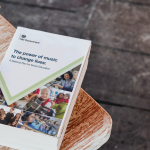Mark Robinson is what you might call a multi-hyphenate creative. A former Executive Director of Arts Council England, North East, he is also a published poet, critic, writer, researcher, facilitator and founder of Thinking Practice.
A culmination of this extensive work across the sector, Mark’s book Tactics for the Tightrope: Creative Resilience for Creative Communities was recently published by Future Arts Centres. It serves as part manifesto, part toolkit for creative resilience as resistance to inequality, hierarchy and irrelevance within our communities.
A book for creative practitioners and board members alike, our CEO Mary-Alice Stack had the opportunity to sit down with Mark to explore how Tactics for the Tightrope can help those who would like to learn how best to connect, collaborate and multiply the voices of creative communities.
Mary-Alice Stack: What do you hope people in the arts sector will learn or try to do differently after reading this book?

Mark Robinson: What I hoped to do when I came up with the idea of Tactics for the Tightrope was partly to bring together some of the key arguments I’d written about over the last decade since I set Thinking Practice up, and partly to update them. It was also an opportunity to join the dots in the light of the experience of COVID – although it isn’t a book about that experience particularly.
I wrote a paper about adaptive resilience when I left Arts Council in 2010 and metaphorically left it on the desk for colleagues to pick up. And so, I wanted to go back to the frameworks as my thinking has changed a bit. The publication connects the notion of adaptive resilience to the work in community, the work that I’ve done with Creative People and Places, as well as with Future Arts Centres and leadership across the sector. There was an argument starting to form around how connected those things are and how they also connect to the fairness of the sector and it’s workforce. I set myself quite an ambitious task!
I’m interested to know more about how you see the role/agency of the individual in relation to the systems that exist within our sector and wider society. Can you say a bit more about this?
This is something I thought about a lot. I think the experience of the last decade – and decades previously in the broader economy – is that lots of things have been individualised rather than collectivised. That has tended to put responsibility on people as individuals. For me, that has some elements of usefulness but also some big limitations because our resilience as individuals, or our agency as individuals, is always constrained and shaped by the traits and patterns we find ourselves living within.
We shouldn’t underestimate our ability to influence these system as an individual, whether that is on a micro or macro level. We equally shouldn’t overestimate our ability- or there are risks if we do so. That is something that I learnt early on in resilience work. It isn’t about just adapting to change, its about influencing change. That is what I am trying to argue in the book: we have to acknowledge the system we work in but we also have to work to influence it. Hopefully the tools I share can help.
In the opening chapter you talk about ‘the damage made in communities by economics’ – can you explain what you meant by this?
I think in many of our communities we see a marketisation of everything. The food systems we have in our communities, for example. The system of food that means if you are on universal credit in Stockton, where I live, if you live in certain parts of the town your money will go further to eat healthier than it would elsewhere because there are very few shops in the larger estates. This implicitly encourages, or you could even say enforces, unhealthy food choices which leads to patterns of ill health in those communities. I live on one of the arterial roads into Stockton, if you live at one end as a man you are likely to live 18 years longer than if you live at the other end. Stockton has one of the largest health inequalities across the country and you can trace that through economics.
The connection I’m making is that this has a psychological or cultural aspect to it as it relates often to identity of place and ideas of family. Those are the sorts of things I am getting at with that sentence…if you look at culture, the idea that you have to pay for everything has certain knock-on effects, to put it neutrally.
Do you think that exposure to precarity, walking the tightrope, is something that we should all be learning to do better or striving to eliminate/minimise from the experience of working in the arts and cultural sector?
I think it is about balance – pun intended. I don’t think we can expect to make culture without risk and without an element of precarity. But we need safe places to work. That, for me, is the trick. It can’t be completely un-precarious. It is so hard to get attention as an artist in any genre, you are always taking a risk when you put yourself out there in your career. At any point in your career you can fall off and you can’t be guaranteed critical or popular attention.
I settled on the tightrope metaphor because it implies the mix of stability and change that I think is integral to both communities and resilience, to use those two key words. If you try and stay still or jump around too much, you are going to fall off. You have to combine stillness and movement at the same time. The weakness of the tightrope metaphor, that I’ve grappled with, is that it can lead to thinking about individuals. I’ve broadened the metaphor out – describing multiple tightropes along with people who are watching and can be there to catch you if you fall – to represent the collective and communal approach to culture that I am more interested in.
You (famously!) coined the term and have written extensively about the need for ‘adaptive resilience’ in the arts sector. In this book you also talk about the need for ‘resistance’, of a collective push against established hierarchies, inequality and irrelevance. How close do you think we might be to a ‘tipping point’ in terms of the change that is needed within the UK’s arts and cultural sector? To what extent do you think that the Covid crisis has been a catalyst for change?
Certainly those ideas are really key to me and to the book. I wanted to go back to my ideas and show how my thinking had changed to reflect that. The notion of resistance, I think I underplayed or wasn’t as aware of ten years ago. The combination of the two, allows you to build and move forwards. In the book, I talk about the critique that adaptive resilience had received, as a coping mechanism at best and a collaboration technique for austerity at work at worst – simply allowing people to survive in a bad system.
But I’ve looked at the work of other academics who look at resilience, particularly in the disaster studies field (New Orleans and Haiti for example), and this allowed me to identify that some cultural organisations are being resilient as a way of holding their ground against some of the forces that might push them in one direction or another. For me, those notions of hierarchy, inequality and irrelevance are some of the key forces that the cultural sector I’m most interested in working on and helping others address.
Hierarchy in terms of how we lead and get ideas into the sector, there are lot of people working to avoid that and I think there is a bit of a tipping point to be seen. Issues of inequality are much more spoken about than they were ten years ago, changing them is a different and slower thing altogether. I feel at times that it is more performative than a tipping point.
You open the book with a poem which speaks to the themes of diversity and infinite variety, as well as familiarity, stability and community. Did you write this poem specifically for the book, or was it selected from an existing collection of poems?
It has been published before – but I wanted the book to feel like my voice in a way. I have an unusual mix of skills. It isn’t an academic text but it draws upon academic thinking… I’m more interested in showcasing a multiplicity of voices – even for myself. I decided to use that poem because it was commissioned by the old Sponsors Club for Arts & business in the North East, for its 21st birthday and it describes lots of artists, makers and businesses that would have sponsored the arts. It captured the variety and diversity of people in a place making stuff, to showcase that our economies and communities are made up of lots of people making things – it’s a creative place. It’s a poem about abundance really and seemed to strike the right tone to open the book.
If you were to choose just one of the tactics and strategies in the book to help you keep your balance in the year ahead, which one would it be?
One of the things I have described in the book is how I use this Japanese derived framework known as Ikigai that I have used with myself, artists, organisations and boards. It simply asks four questions:
- What do you love doing?
- What does the world need?
- What can you get paid for?
- What are you good at?
For me, as an individual freelancer – I am aiming for the sweet spot that connects all four of those answers. For me that has been a helpful framework for understanding why you might get frustrated or feel squeezed in. If you are doing something that the world needs and you can get paid for, but you aren’t very good at it, occasionally that could be an exciting place but also a scary place as you could be out of your depth. Often artists or creative workers find themselves doing something they are good at and get paid at, but don’t love doing. It is a simple framework but it is one that you can think of during a walk around the block.
If I had to pick one it would be that…but I wouldn’t pick one! And I wouldn’t because, as the saying goes, if you only have a hammer, everything begins to look like a nail. I remember coming across that saying when working at Arts Council England and applying it there – if you only give grants, everything begins to look like a grant recipient. The set of tools is deliberately very various, I wanted to pass it on in a simple way that was easy to replicate and adapt. Pass on the skills and people will make what culture they want with it.
Tactics for the Tightrope: Creative Resilience for Creative Communities was published by Future Arts Centres in July 2021 and is available to purchase now. A FREE digital download is also available from Future Arts Centres.







